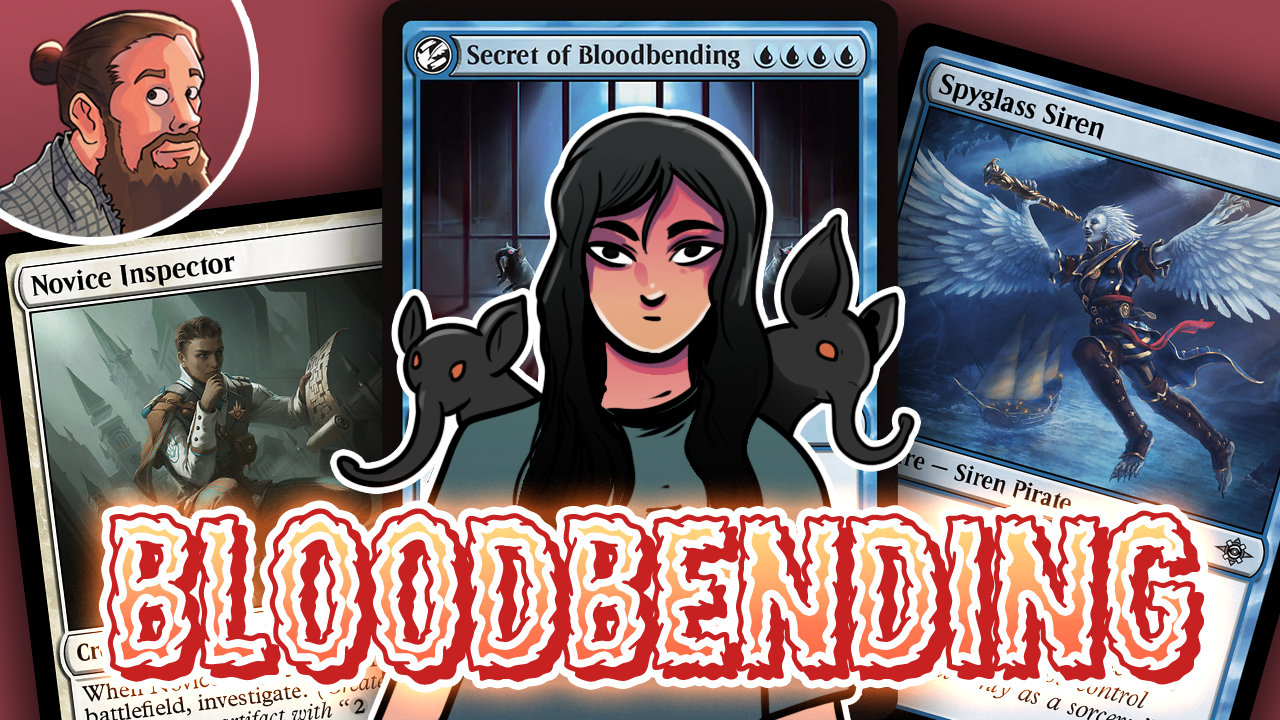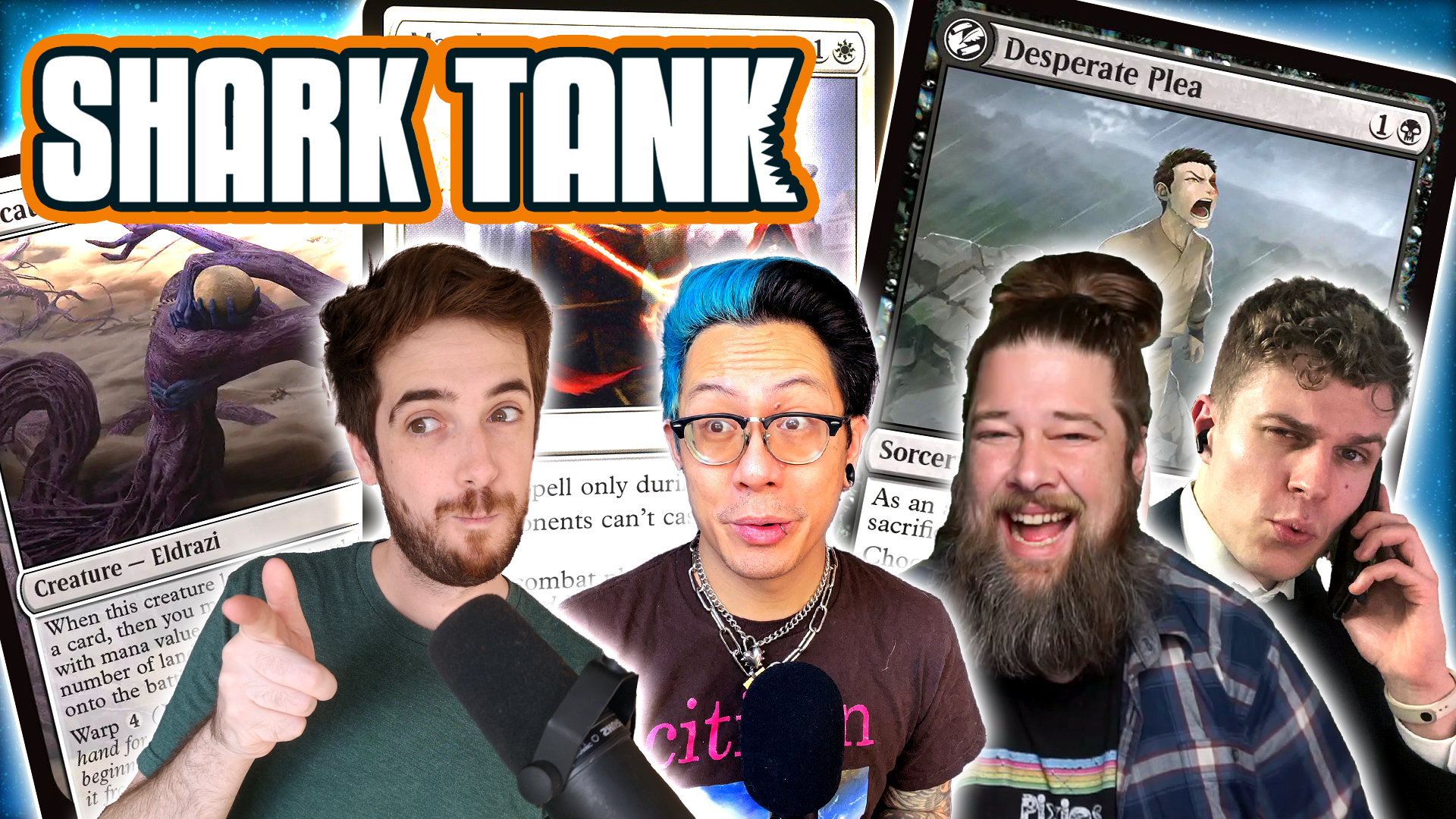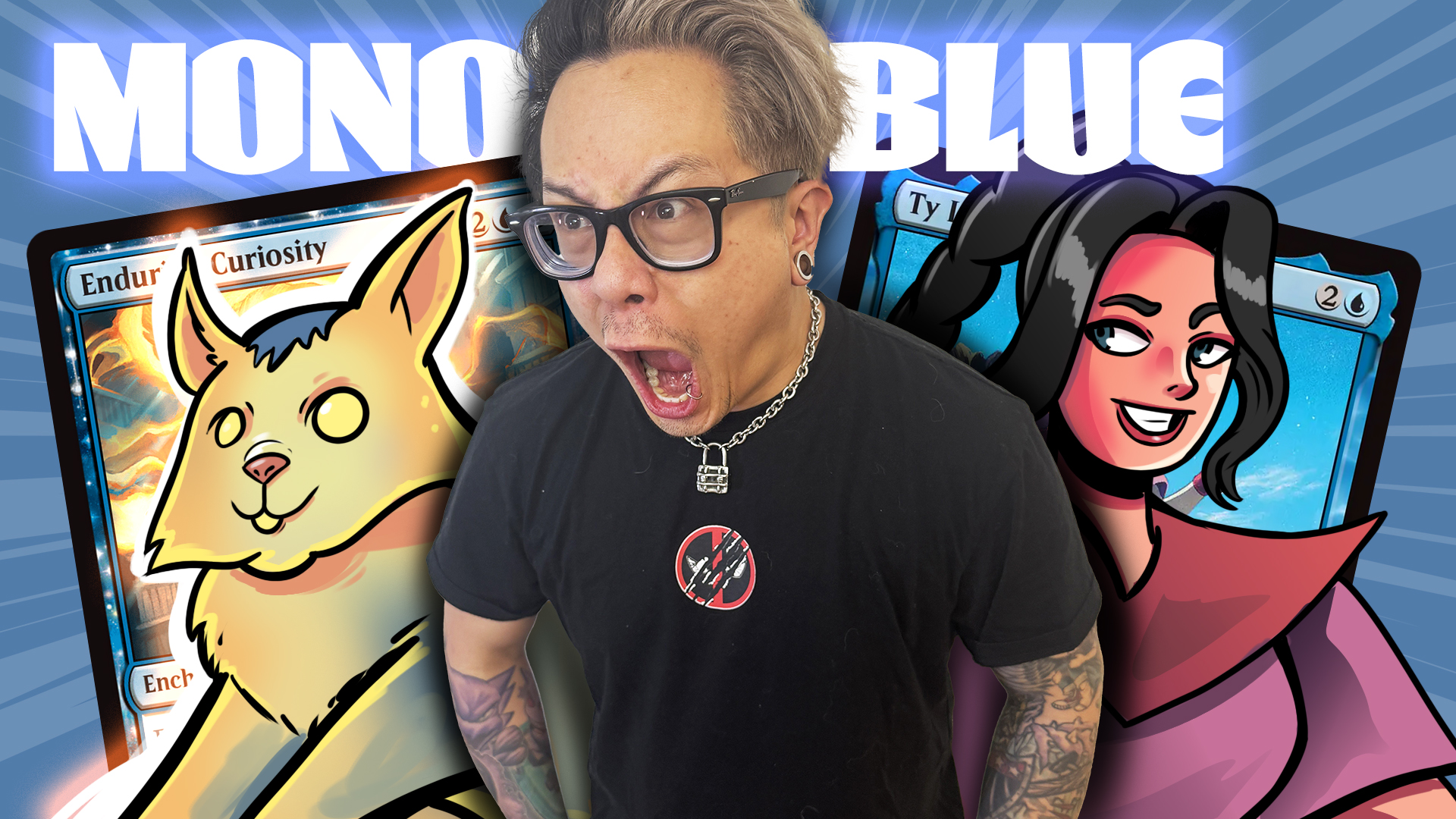Half Way There: The Mythics of Fate Reforged
While this week was only the first week of Fate Reforged spoilers, it might as well have been the week of Fate Reforged spoilers since the majority of the important cards from the set have already been spoiled. In fact, according to the Name and Number Crunch on MTG Salvation, a full 80 percent of the rares and mythics are already known, leaving but two mythics and seven rares for next week. This means we have a lot to talk about and it's becoming clear that not only this set, but Khans of Tarkir block in general is shaping up to be unique in more ways than one. Today I want want to share an observation about Khans of Tarkir block as a whole, talk about one of the most important ways that Fate Reforged is unique, and then discuss the financial implications of several of the mythics spoiled this week.
Khans of Tarkir Block is Scars of Mirrodin in Reverse
Think back to Scars of Mirrodin for a second. What do you remember? Maybe the war between Mirran and Phyrexia complete with fake Mirrodin Pure products? Now much has been made of Khans of Tarkir's unique block structure — both in how it will be drafted, and the back-in-time reverse chronological story line — but when it comes right down to it, the sets in Khans of Tarkir block are starting to feel a bit like Scars of Mirrodin.

Scars of Mirrodin, the big fall set of the block, was basically a re-introduction to the plane, and the set was dominated by the Mirran. There were only 15 infect creatures (Phyrexia's presence) in the entire set. Mirrodin Besiged, the winter set, was the battleground, and contained an even mix of Mirran and Phyrexians (exemplified by the mirror image cards Mirran Crusader and Phyrexian Crusader). By the time New Phyrexia rolled around in the spring, it was all about Phyrex, about Phyrex, no Mirran (I tried to get Meghan Trainor to sing that last line, but she turned me down). New Phyrexia, as a small set, contained more infect creatures (18 by my count) than the much larger Scars of Mirrodin, and the mythic slot was dominated by the Phyrexian Praetors.
Khans of Tarkir, similar to Phyrexians in Scars of Mirrodin, contained no dragons at all. Instead, it only referenced the creature type in the back-story of Sarkhan, the Dragonspeaker. With the spoiling of most of the Fate Reforged mythics, all of which seemed to be aligned with the Khans rather than the Dragons, Fate Reforged seems to be a Mirrodon Besieged battleground set, with the major difference being we already know who wins - the Khans (as seen in the dragonless future in Khans of Tarkir).
This leads me to believe that Dragons of Tarkir will be to Khans of Tarkir block what New Phyrexia was to Scars of Mirrodin block: a set dominated by the group ignored in the big fall set. In this case, Dragons. With most (all?) of the Fate Reforged mythics being Khans-aligned (and the only dragons we've seen so far being at rare), I expect this to flip in Dragons of Tarkir, with a bunch of powerful mythic dragons and the Khans at rare only. Not to mix my set analogies, but its seems very likely that Dragons of Tarkir will be to the dragon creature type what Avacyn Restored was to angels: containing a mix of hugely powerful (and high mana-cost) casual cards like Avacyn, Angel of Hope, as well as more efficient competitive cards like Sigarda, Host of Herons.
All of this is speculation, of course, and Dragon of Tarkir is the in distant future (past), so let's get to what I'm sure you came here for: some Fate Reforged discussion.
Why Fate Reforged (and Khans of Tarkir in General) is Unique: The Mythics
I realize that not quite all of the Fate Refoged mythics have been spoiled, but thus far we are seeing something unprecedented in the history of the mythic rarity: a huge influx of low converted mana cost mythic creatures (what I like to call Voice of Resurgence-syndrome). In my article on Soulfire Grand Master, I talked about how a huge percentage of low converted mana cost mythics are either Standard playable or format staples. This was before Wizards of the Coast continued to spoil more cheap and efficient tournament-focused mythic rares in Fate Reforged.
By now I'm sure you're familiar with my love of statistics and graphs. So, for today, I went back and broke down every mythic rare creature ever printed in a Standard legal set by mana cost. Let's look over the data, and then I promise, I'll conclude by talking about the Fate Reforged mythics individually.
First off, how many cheap mythics creatures do blocks normally have? The following graph shows the percentage of the total number of mythic creatures in a block that have a converted mana cost of four or less.
* The calculations on Theros block are weird due to more than a third of all mythics being gods. I wasn't sure how to handle these enchantment creatures. If they were just straight up creatures with their abilities, it's hard to imagine any of them being costed at four or less. In the end, I just left them off all together, which means Theros block has less than half the amount of creature mythics than any other set. Also, since this graph was made, two more 4-CMC mythic creatures were spoiled, driving the percentage up even higher - to a full 60 percent.
Based solely on the CMC of mythic creatures, Khans of Tarkir block is unique, with by far the highest ratio of 4-CMC and under creature of any block ever printed. In fact, if you average the percentage of 4-CMC and under mythics from the other six blocks, you'll find that over the history of the mythic rarity, only 26 percent of mythic creatures cost four or less to cast. Khans of Tarkir block to date has twice the rate of low-CMC mythics as the historical average, coming in at 54 percent. While part of this ratio might be attributable to incomplete data, for Khans of Tarkir block to hit the average of 26 percent, every mythic in Dragons of Tarkir will have to be not only a creature, but costed at 5+ CMC .
I used this next graph in my last article: It shows that the majority of 3-CMC or less mythic creatures are standard staples or at least very playable cards in the format.

But what if we expand the sample out to mythic creatures with a converted mana cost four or less? This more than doubles the number of cards we are studying from 21 at three-or-less to 52 at four-or-less. How do this change the playability statistics?
As you can see, the percentage of cards that are either staples or role players in Standard is basically the same when you add in the 29 four CMC mythics. So historically, four CMC mythic are just as playable as three CMC mythics. However, for this to really mean anything, we need to know just how many mythics creatures in general are playable in Standard. For this we turn to one more pie chart, this time including every mythic creature ever printed in a standard legal set at any converted mana cost. Using this method bring our sample up to 188 mythic creatures printed in Standard legal sets.
As you can see, if you consider all mythic creatures, 54 percent are played in Standard, 28 percent are true staples, while 26 percent are role players. The other 46 percent are are bulk, a term I am using not so much to refer to price, but level of play (although these two variable often go hand-in-hand). This represents a huge change from our four-CMC-or-less sample, where a full 40 percent of mythic creature are Standard staples, and over 70 percent are playable in the format.
What All This Means
Right now you're probably wondering, why does any of this matter? Well, stay with me. If Khans of Tarkir block (and Fate Reforged specifically) has an abnormally high numbers of low-converted mana cost mythic creatures, and low-CMC mythics are almost always Standard playable, and Standard playable mythics are more expensive than underplayed mythics, this leads us to two important conclusions:
1. All of these Mythics Will Be Fighting for a Finite Amount of Expected Value
I'm looking forward to writing an article on the expected value of Fate Reforged once the set is fully spoiled: I've written these articles for years, first for my own benefit, to see if a box was worth buying, then for Reddit, and now for MTGGoldfish. While I'll explain the whole EV thing in that article, the basic idea is that the cards you can expect to open from a booster box (or pack) cannot be worth more than the price you pay for the pack. This only applies to in-print sets, and the irrational hyped-up spoiler season is excluded.
Generally speaking, at buylist values, the cards you open from a $100 booster box will be worth somewhere around $70 once the set is opened for a few weeks. If you consider that there are 10 mythics in Fate Reforged and that you will, on average, open 4.5 per box, this mean, assuming every rare, uncommon, and common in the set is valueless, the average price of a mythic would max at $15.50. Since rares and some uncommon have value, even $15.50 is too high. Let me give you a few examples of how this value can break down.
Total EV of Box: $70. Average Mythic $15.50, Average Rare $0.00, Average Uncommon, $0.00 - Total Value $70.
Total EV of Box: $70. Average Mythic, $10.00, Average Rare $0.63, Average Uncommon $0.05 - Total Value $70.
Total EV of Box: $70. Average Mythic, $6.00, Average Rare $1.04, Average Uncommon $0.09. - Total Value $70.
Total EV of Box: $70. Avearge Mythic, $3.00, Average Rare $1.47, Average Uncommon $0.09 - Total Value $70.
All of these breakdown are possible, as well as millions of others in between (feel free to play with the numbers, to see how the prices of one rarity impact the prices of other rarites). As far as the mythics of Fate Reforged, what this means is they are going to be fighting each other for their share of the mythic slot. Right now, the average price of the five spoiled mythics is $16.32, which is simply not sustainable if any other card from the set (including fetch lands) are going to have a non-zero value.
The EV issue is compounded in Fate Reforged specifically due to the presence of Khans of Tarkir fetch lands in the basic lands slot. Since we still dont' know how often you'll find a fetch land in Fate Reforged, I'm still running on the Dragon's Maze assumption of 1.5 per box. What this means is, assuming a fetch is worth $10, another $15 of total box value is eaten up by a slot that is usually valueless. So if a normal box contains $70 of value between the mythic, rares, uncommons, and commons, the non-land cards in Fate Reforged will only have $55 of expected value between them.
2. Rares Will Be Worth Less (or, judging by the spoilers so far, worthless).
Assuming that the mythics will be soaking up an abnormally large share of the set's total worth, and considering that fetchlands will be chipping away even more value, the biggest loser is likely to be the rares. While a bulk rare will still be bulk, the impact will be seen with rares that see some amount of Standard play. They might be worth a couple bucks in another set, but in Fate Reforged, these cards will likely trend towards bulk (or just above), simply because there is not enough value to go around.
To sum all of this up, Fate Reforged has a lot of low CMC mythics. Low CMC mythics are, on average, more playable (and therefore more valuable) than high-CMC mythics. Because of this, it's likely that a handful of mythics, along with the basic-land-slot fetchlands, will eat up a disproportionate amount of the value of Fate Reforged. This also means that non-premium mythics and most rares will be less valuable than usual. Anyway, enough of this expected value talk, let's look at the first five mythics spoiled from Fate Reforged.
The Mythics of Fate Reforged
Soulfire Grand Master
I have already written 2,000 words on Soulfire Grand Master, so I will spare you another in-depth discussion (if you're interested, you can check it out here). It is worth mentioning that the spoiling of another high-powered mythic (which we will talk about momentarily) seems to support the Grand Masters playability, although it could hurt Soulfire Grand Master's price a bit once the hype of spoiler season dies down.
Either way, I still think the Grand Master is an extremely powerful card. While it's will likely fall from its pre-order price into the mid-to-low teens by the time M16 is released this summer, the closer this card gets to $10, the more attractive it becomes as a rotation pick-up and it's not impossible that Soulfire Grand Master will return to its preorder price next fall.
Monastery Mentor
Monastery Mentor is the other white mythic I just mentioned, and this is the card that made me question my pick of Soulfire Grand Master as the chase mythic of Fate Reforged. This card is basically a better Young Pyromancer — a card that has proven itself in formats as powerful as Vintage — and Monastery Mentor has potential to be a staple in Modern as well as Standard.
While I haven't tested the card yet, in theory it should be insane in the Delver of Secrets/Treasure Cruise decks in Modern (and maybe even Legacy). While requiring white mana is annoying, Monastery Mentor rewards Delver for doing what the deck does - playing a bunch of cheap spells to power up Treasure Cruise. The upside is that, instead of making 1/1 tokens like Young Pyromancer, Monastery Mentor generates prowess tokens while pumping itself to attack.
Picture a curve of Delver of Secrets or Monastery Swiftspear on turn one into Young Pyromancer on turn two into Monastery Mentor and Gut Shot or Gitaxian Probe on turn three. If you can muster two or three spells (Lightning Bolt, Forked Bolt, and the like), you're looking at a very realistic turn four kill considering prowess. In short, Monastery Mentor alone should cut an entire turn off the clock of a Modern Delver deck.
In Standard, Monastery Mentor could join the Soulfire Grand Master in a new build of Jeskai which looks hard to beat, especially if Jeskai Ascendency remains a part of the format. It seems possible that Monastery Mentor is just better than Mantis Rider . With Jeskai Ascendency and Monastery Mentor in play, things get even more intense: Each non-creature spell not only creates a token, but buffs all of your creatures by +2/+2, not to mention looting for more non-creature spells to do it all again. If I was building the deck, I would start with Wantabee's Jeskai Token build and go from there, maybe ending up with something like this:

I really want four Soulfire Grand Master in the 75, although fitting four in the main deck while still keeping enough spells to make the prowess/token theme work is challenging. I ended up splitting them between the maindeck and the sideboard. Against slower decks, bringing all four Soulfire Grand Masters and some counters makes the Forbid lock a realistic possibility, and just having an endless supply of Disdainful Stroke against midrange seems strong.
Building this deck leads to another question: What does the printing of Monastery Mentor mean for Goblin Rabblemaster? We are already heading into the month where Standard cards rotating in the fall peak, and it seems possible that Monastery Mentor takes over at least some of Goblin Rabblemaster's market share in Standard. So maybe the time to dump your Goblin Rabblemasters is now, rather than in a few weeks or months (assuming your not playing them).
Of course I could be wrong, and I'll defer to better deck builders than myself regarding Goblin Rabblemaster or Monastery Mentor being correct in the deck. But I did just sell my Goblin Rabblemasters on Magic Online a couple week ago, and this is just another confirmation that I made a solid decision. I'm not suggesting you panic sell, but it is worth thinking about where Goblin Rabblemaster fits in the post-Fate Reforged format.
As for the price of Monastery Mentor, it should be the most expensive card in the set when everything is said and done. As I mentioned in my Soulfire Grand Master article, it's hard to see any of these mythics reaching Voice of Resurgence levels, simply because Fate Reforged will be opened more than Dragon's Maze, but assuming Monastery Mentor does see some Modern play or beats out Goblin Rabblemaster, it's not out of the question that it will be one of the exception-mythics to maintain its pre-sale price of between $20 and $25. I'm not convinced there is money to be made by buying in now, but keep your ear to the ground as the Modern Pro Tour approaches. If a team like Channel Fireball plays a Monastery Mentor deck, it could spike to $40 overnight before falling back to earth.
Whisperwood Elemental
I still have no idea what to make of Whisperwood Elemental. It seems Whisperwood Elemental has the highest ceiling and lowest floor of any mythic in the set. I could see it doubling its current price or being a bulk mythic — take your pick. The question is, is Whisperwood Elemental more Huntmaster of the Fells or Turntimber Ranger.
The answer is likely somewhere in between. I'm not sure that Whisperwood Elemental is quite as powerful as cards like Huntmaster of the Fells or Master of the Wild Hunt — these are the premiere green mid-range creatures that create a 2/2 every turn. But then again, maybe I am underestimating the power of manifest. The ability can be more (or less powerful) than it appears on paper once you actually get to play with it in a game. I mean, manifesting a Polukranos, World Eater is obviously much more powerful than making a 2/2 vanilla token, and providing wrath-protection is nice (although not relevant unless control decks shift away from Perilous Vault and towards Crux of Fate or End Hostilities).
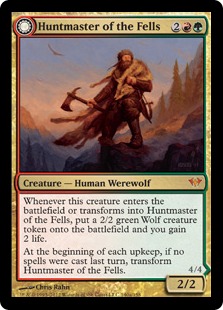



Because I have no idea how good this cards is, I'm not buying. I readily admit that I could be missing out, but this is a risk I'm willing to take given all of the unknowns regarding its playability.
Shaman of the Great Hunt
My initial gut reaction on this card was that is was pretty bad, but it has started to grow on me. Hasty red four-drops have a very mixed history in recent years, either being among the premiere cards in their formats like (Hellrider and Hero of Oxid Ridge) or being completely unplayable like Oracle of Bones and Archwing Dragon. While I'm not sure Shaman of the Great Hunt is quite as good as Hellrider (because it actually needs your team to deal damage to trigger), it seems like a card that a Kibler-esque Temur Aggro deck might want to top its curve.
Being a small set mythic, Shaman of the Great Hunt probably doesn't need to be as good as Hellrider to maintain some value, although its preorder price of $12 is likely too high. I would expect Shaman of the Great Hunt to mirror the price trajectory of Hero of Oxid Ridge:
The one way this could change is if the Shaman of the Great Hunt finds a home in a deck that can really abuse the card drawing ability. If you can somehow activate it with Savage Knuckleblade, Stormbreath Dragon, and Polukranos, Worldeater on board, you're drawing four cards for four mana, which is super powerful.
I guess what I'm trying to say is, the one way I can see Shaman of the Great Hunt increasing from its pre-order price is if it manages to be a Consecrated Sphinx/Hero of Oxid Ridge split card. While this is probably unlikely, it's not completely impossible.
Temporal Trespass
When Temporal Trespass started out at $30, I wanted to cry. Had we learned nothing from Temporal Mastery?
On the other hand, $5 is completely reasonable for a Time Walk. Any Time Walk actually.
![]()


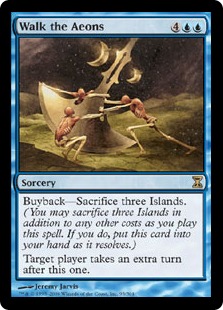
There is one major problem with Temporal Trespass, which not only drastically decreases its playability, but also makes me just a little bit mad at Wizards of the Coast. This problem is the UUU casting cost. Every Time Walk since Time Walk has been printed at UU, which makes it difficult to splash, but not impossible. Temporal Trespass, on the other hand, needs a lot of blue which means you can't just toss it into many (or maybe any) current decks.
Why this makes me a little bit angry with Wizards of the Coast is that it shows that they know that delve cards need a slightly higher color commitment (somewhere between one and two additional colored mana) to be fair. Take a look at the three big delve spells printed in Khans of Tarkir block up against their closest Alpha comparison.
![Temporal Trespass [FRF]](http://cdn1.mtggoldfish.com/images/gf/Temporal%2BTrespass%2B%255BFRF%255D.jpg)
![Time Walk [LEA]](http://cdn1.mtggoldfish.com/images/gf/Time%2BWalk%2B%255BLEA%255D.jpg)
![Dig Through Time [KTK]](http://cdn1.mtggoldfish.com/images/gf/Dig%2BThrough%2BTime%2B%255BKTK%255D.jpg)
![Demonic Tutor [LEA]](http://cdn1.mtggoldfish.com/images/gf/Demonic%2BTutor%2B%255BLEA%255D.jpg)
![Treasure Cruise [KTK]](http://cdn1.mtggoldfish.com/images/gf/Treasure%2BCruise%2B%255BKTK%255D.jpg)
![Ancestral Recall [LEA]](http://cdn1.mtggoldfish.com/images/gf/Ancestral%2BRecall%2B%255BLEA%255D.jpg)
Adding additional colored mana means that regardless of how well stocked your graveyard happens to be, Dig Through Time is worse than Demonic Tutor and Temporal Trespass is worse than Time Walk. For some unknown reason, Wizards of the Coast broke protocol with Treasure Cruise, making it so the only thing that separates it from its Power 9 kin is your graveyard, which we have known since Dredge was printed, is a broken place to be.
This mostly makes me mad because I like drawing cards, and if Treasure Cruise cost UU it would be much more likely to avoid the ban hammer.
As for Temporal Trespass, the card has a floor of $4, with a ceiling of at least $10. While I'm loathe to speculate on cards during spoiler season because the odds of picking the right ones sometimes makes slot machines seem like a value play, if I was going to spec one of the currently spoiled mythics, this would be the one. It's pretty much at its floor during the pre-sale period, which is strange. Even Star City Games, who generally milks every drop from presales, has a bunch of copies available for only $5.99 (which is inline with ebay prices).
Conclusion
I only managed to talk about half of the mythics in Fate Reforged today, but since spoiler season is on-going, I needed to click submit at some point or the article would never see print. Don't worry, I'll be back to discuss the financial impact of more Fate Reforged cards soon.
Like always, leave your thoughts in the comments, or hit me up on Twitter or Magic Online @SaffronOlive.
Until next time, may all your Fate Reforged mythics be white.





